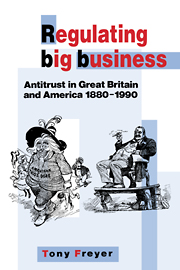Book contents
- Frontmatter
- Contents
- Preface
- Introduction
- 1 The response to big business: the formative era, 1880–1914
- 2 The divergence of economic thought
- 3 The political response
- 4 The courts respond to big business
- 5 The impact of World War I, 1914–1921
- 6 Tentative convergence, 1921–1948
- 7 A British antimonopoly policy emerges, 1940–1948
- 8 Uneven convergence since World War II
- Conclusion
- Notes
- Index
4 - The courts respond to big business
Published online by Cambridge University Press: 21 January 2010
- Frontmatter
- Contents
- Preface
- Introduction
- 1 The response to big business: the formative era, 1880–1914
- 2 The divergence of economic thought
- 3 The political response
- 4 The courts respond to big business
- 5 The impact of World War I, 1914–1921
- 6 Tentative convergence, 1921–1948
- 7 A British antimonopoly policy emerges, 1940–1948
- 8 Uneven convergence since World War II
- Conclusion
- Notes
- Index
Summary
Consensus shaped the course of British decisions whereas American judicial opinions were molded by conflict. The consensus favoring business self-regulation, the principle of Parliamentary supremacy, and the dominance of a Free Trade ideology limited British judges to a passive role. By contrast, in America the insecurity of small business, the constitutional doctrine of judicial review, and the ideological tension between republican values and laissez-faire fostered judicial activism. The economic transformation big business represented required both countries' judges to alter old common-law doctrines, resulting in the more flexible standard of reasonableness. Yet, because of the legal uncertainty among the states and the vagueness of the Sherman Act, British courts established a much narrower and less significant rule of reason earlier than their American counterparts. The divergent character of legal thought and the market for lawyers' services in each country reinforced the prevalence of judicial self-restraint or activism. The pervasiveness of struggle ensured, moreover, that courts influenced the course and impact of the great merger wave much more in America than Britain.
Former President William Howard Taft explained how judicial activism and the giant corporations' corruption of republican government were linked. He declared that the purpose of the Sherman Act was to prevent restrictive practices which “had resulted in the building of giant and powerful corporations, which had, many of them, intervened in politics and through the use of corrupt machines and bosses threatened us with a plutocracy.” The judiciary's constitutional independence enabled the Supreme Court to meet this challenge by employing an activistic reinterpretation of the Sherman Act in conformance with changing public opinion.
- Type
- Chapter
- Information
- Regulating Big BusinessAntitrust in Great Britain and America, 1880–1990, pp. 121 - 158Publisher: Cambridge University PressPrint publication year: 1992



